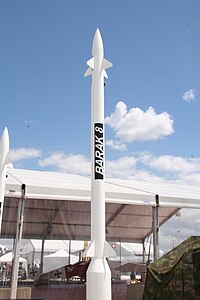Barak 8
| The new Barak 8 | |
|---|---|
 | |
Type | The new Barak 8, essentially a Barak II Medium range surface-to-air missile |
| Place of origin | Israel & India |
| Production history | |
| Manufacturer | Israel Aerospace Industries &Rafael Advanced Defense Systems |
| Specifications | |
| Weight | 98 kg |
| Length | 2175 mm |
| Diameter | 170 mm |
| Warhead | 22 kg blast fragmentation warhead |
| Detonation mechanism | Proximity fuze |
| Wingspan | 685 mm |
| Operational range | 70 km |
| Flight altitude | 500 m - 5.5 km |
| Speed | 720 m/sec |
| Guidance system | Radar CLOS guidance |
| Launch platform | Surface Ship |
Barak (the Hebrew word for Lightning) is an Israeli surface-to-air missile (SAM) designed to be used as a point-defense missile system on warships, defending against aircraft, anti-ship missiles, and UAVs.
Overview
Barak 8
In January 2007, after several months of intense negotiations, India and Israel signed a US$330 million deal to co-develop an all new generation of the Barak SAM, which was to be known as the Barak II. It has also been called Barak 8.They have worked out an agreement to develop and produce the long-range Barak air defence system for both the Indian and the Israeli militaries. The initial co-development funding is about US$350 million, of which IAI will finance 50 per cent. The venture is a tripartite one, between the DRDO, the Indian Navy, and IAI. The missile is referred to as the LRSAM in Indian Government literature, and will have a range of 70 km (43 mi).The new missile, which will be based on the original Barak, is expected to feature a more advanced seeker, alongside range extensions (up to 70 km) that will move it closer to medium range naval systems like the RIM-162 Evolved Sea Sparrow or even the SM-2 Standard. The joint development offer was first made by Israel during Indian Navy Chief Admiral Arun Prakash's visit to Tel Aviv in 2004. Israel successfully tested its improved Barak II missile on July 30, 2009.The radar system provides 360 degree coverage and the missiles can take down an incoming missile as close as 500 meters away from the ship. Each Barak system (missile container, radar, computers and installation) costs about $24 million. In November 2009 Israel signed a $1.1 billion contract to supply an upgraded tactical Barak-8 air defence system to India. The dual pulse rocket motor for the SAM was developed by DRDO, and the prototypes were supplied to IAI for integration with IAI systems to develop the complete missile.The other variant of the LRSAM will be fielded by the Indian Air Force.Along with the Akash SAM, the LRSAM fills a longer range requirement and both types will complement each other.Each unit of the MR-SAM, would consist of a command and control center, with an acquisition radar, a guidance radar, and 3 launchers with eight missiles each.A 4-year, US$300 million System Design & Development phase to develop unique system elements and an initial tranche of the land-based missiles is estimated. The radars, C2 centers, TEL's and missiles will be codeveloped by Israel and India. In turn, IAI and its Israeli partners have agreed to transfer all relevant technologies and manufacturing capabilities to India allowing India to manufacture the LRSAM systems locally as well as support them.
In May 2010, the Barak-II missile was successfully test fired at an electronic target and met with its initial objectives. The second test of the missile is to be held in India later this year."More than 70 per cent of the content in the missile being developed with Israel would be indigenous." DRDO chief V K Saraswat told The Economic Times.

No comments:
Post a Comment